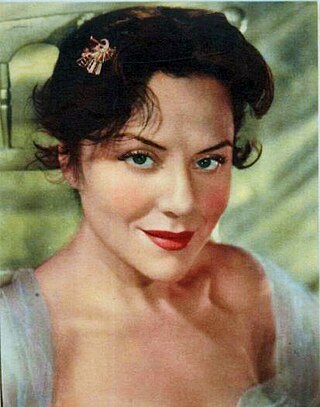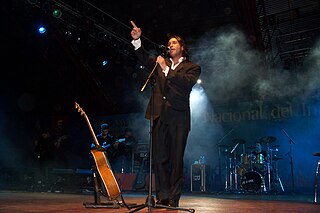
The music of Argentina includes a variety of traditional, classical, and popular genres. According to the Harvard Dictionary of Music, Argentina also has "one of the richest art music traditions and perhaps the most active contemporary musical life."

The Chacarera is a dance and music that originated in Santiago del Estero, Argentina. It is a genre of folk music that, for many Argentines, serves as a rural counterpart to the cosmopolitan imagery of the Tango. A dance form played by contemporary musicians as soloists or in small ensembles of voice, guitar, violin and bombo drum, the Chacarera is often legitimized by its “origin” in the remote province of Santiago del Estero.
LRA Radio Nacional, also known as Radio Nacional Argentina, is the Argentine national radio station, and part of the national public media system. It started transmitting in 1937 as LRA Radio del Estado and changed its name to the current one in 1957. Since 1949, National Radio is also in charge of the Radiodifusión Argentina al Exterior, an international service that broadcasts in numerous languages.

Amelia Bence was an Argentine film actress and one of the divas of the Golden Age of Argentine cinema during the 1930s and 1950s.

Laura Ana "Tita" Merello was an Argentine film actress, tango dancer and singer of the Golden Age of Argentine cinema. In her six decades in Argentine entertainment, at the time of her death, she had filmed over thirty movies, premiered twenty plays, had nine television appearances, completed three radio series and had had countless appearances in print media. She was one of the singers who emerged in the 1920s along with Azucena Maizani, Libertad Lamarque, Ada Falcón, and Rosita Quiroga, who created the female voices of tango. She was primarily remembered for the songs "Se dice de mí" and "La milonga y yo".

Luciano Ariel Pereyra is an Argentine singer-songwriter.

Elías Isaac Alippi was an Argentine actor from the Golden Age, theatrical impresario, film director and theater director, who was born and died in Buenos Aires. He is also remembered as an excellent tango dancer.

The Cosquín Folk Festival is one of the most important folk music festivals of Argentina, and most important in Latin America.
Nicole Nau is a German dancer of Tango Argentino and Argentine folklore living in Argentina and Germany.

Luis Pereyra is a dancer and choreographer of Tango Argentino and Argentine folk dances.

Olinda Bozán was an Argentine film actress and comedian of the Golden Age of Argentine cinema. Born into a circus family, she acted on the vaudeville circuit, and performed in silent and sound movies. She was trained by the Podestá brothers, one of whom she married, who have one of the most prestigious Argentine acting awards named for them. Bozán appeared in 75 films and was considered one of the best comic actors of Argentine cinema in the 20th century.

María Ruanova was an Argentine dancer, choreographer, teacher and ballet master, known for her performances at the Teatro Colón and internationally. She is considered the first Argentina-grown ballet dancer to gain international fame.

Sabina Olmos (1913–1999) pseudonym of Rosa Herminia Gómez Ramos was an Argentine film actress of the Golden Age of Argentine cinema.

Cecilio Pablo Fernando Podestá was a Uruguayan-Argentine stage actor, singer, acrobat, sculptor and painter. He is considered to be one of the most prominent actors of classical Argentina theatre, and along with his brothers, was one of the founders of the Circo criollo. A number of institutions and places are named after him, including a town in Buenos Aires Province, and film awards known as the Premios Pablo Podestá.

Tango Argentino is a musical stage production about the history and many varieties of Argentine tango. It was created and directed by Hector Orezzoli and Claudio Segovia, and premiered at the Festival d'Automne in Paris in 1983 and on Broadway in New York in 1985. The Mel Howard production became a world-wide success with numerous tours culminating with a Broadway revival in 1999–2000. It set off a world-wide resurgence of tango, both as a social dance and as a musical genre. Tango Argentino recreates on stage the history of tango from its beginnings in 19th-century Buenos Aires through the tango's golden age of the 1940s and 50s up to Piazzolla's tangos. Most of the dancers in the show did their own choreography.
The 21st Annual Premios Gardel ceremony were held on May 14, 2019. The TNT Latin America networks broadcast the show live from the Ángel Bustelo Auditorium in Mendoza. It was the first time that the ceremony was held outside Buenos Aires. The ceremony recognized the best recordings, compositions, and artists of the eligibility year, which ran from January 1, 2016 to January 31, 2016. The nominations were announced on April 16, 2019 at the Néstor Kirchner Cultural Centre in Buenos Aires.
The 23rd Annual Premios Gardel ceremony was held on July 23, 2021, and it was presented with no in-person ceremony due to the COVID-19 pandemic. The television broadcast of the show was in charge of the TNT Latin America, while LRA Radio Nacional provided radio coverage. The ceremony recognized the best recordings, compositions, and artists of the eligibility year, which ran from January 1, 2020 to January 31, 2020. The nominations were announced on May 7, 2021. The ceremony was hosted by television personalities Jey Mammón and Eleonora Pérez Caressi.
Roberto Herrera is an Argentinian dancer, choreographer and dance teacher, known for the Tango.

The folkloric music of Argentina traces its roots to the multiplicity of native indigenous cultures. It was shaped by four major historical-cultural events: Spanish colonization and forced African immigration caused by the slave trade during the Spanish domination ; the large wave of European immigration (1880–1950) and the large-scale internal migration (1930–1980).

Blanca Vidal Cano was a Spanish-born actress who mainly performed in Argentine theater and films.












